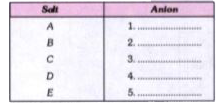A student perfomed the experiment of heating ferrous sulphate crystals in a boiling tube. He smelt fumes of a pungent gas and saw colours of ferrous sulphate disappear.
(i) Write the chemical formula of the pungent gas.
(ii) Why does the colour of crystal disappear ?
(iii) Identify the nature of this chemical reaction.
(i) SO2→ Sulphur dioxide
SO3→Sulphur trioxide
(ii) Ferrous sulphate crystal contain 7molecules water of crystallization (FeSO4.7H2O). These crystals are green in colour. When these crystals are heated, they first lose 7 molecules of water od crystallization to form anhydrous ferrous sulphate (FeSO4) whis is white in colour.
(ii) It is a thermal decomposition reaction
2FeSO4GreenHeat−−−−−−−−−→(decompositon)Fe2O3(s)+SO2(g)+SO3(g)
because in this reaction one substance is splitting up into three substances on heating.
Similar Questions
2g of ferrous sulphate crystals are heated in a dry boiling tube. (i) List any two observations. (ii) Name the type of chemical reaction taking place. (iii) ‘Write the chemical equation for the reaction.
View Solution2g of ferrous sulphate crystals are heated in a boiling tube.
(i) State the colour of ferrous sulphate crystals both before heating and after heating.
(ii) Name the gases produced during heating.
(iii) Write the chemical equation for the reaction.
View SolutionFerrous sulphate decomposes with the evolution of a gas having a characteristic odour of burning sulphur. Write the chemical reaction involved and identify the type of reaction.
View SolutionAn element X which is a yellow solid at room temperature shows catenation and allotropy. X forms two oxides which are also formed during the thermal decomposition of ferrous sulphate crystals and are the major air pollutants
(a) Identify the element X
(b) Write the electronic configuration of X
(c) Write the balanced chemical equation for the thermal decomposition of ferrous sulphate crystals ?
(d) What would be the nature (acidic/basic) of oxides formed ?
(e) Locate the position of the element in the modern periodic table.
View SolutionOn heating blue coloured powder of copper (II) nitrate in a boiling tube, copper oxide (Black), oxygen gas and a brown gas X is formed
(a) Write a balanced chemical equation of the reaction.
(b) Identify the brown gas X evolved.
(c) Identify the type of reaction.
(d) What could be the pH range of aqueous solution of the gas X ?
View Solution(i) You are provided with two test tubes containing an aqueous solution of carbonateand sulphite respectively. How will you identify them?
(ii) A colourless salt on heating, forms a white sublimate on the cooler sides of the lost tube. The gas evolved is colourless and has a pungent smell. It givos donse white fumes when a rod dipped in conc. HCl is brought near the mouth of the fest tube. Identify the basic radical present in the salt.
View Solution(a) Name the gas which is liberated when an acid reacts with a metal ? How will you test the presence of this gas ?
(b) Write the chemical equation for the reaction of zinc metal with (i) Hydrochloric acid and (ii) With sodium hydroxide. Write the chemical name of salt obtained in each case.
(c) Identify the acid and base for ammonium chloride salt. What would be the nature of this salt ? mention the pH range of this salt.
View SolutionWhen a substance 'X' was heated with slaked lime, a gas 'Y' with a pungent smell was formed. The gas y gave pink colouration to phenolphthalein.
Write a balanced chemical equation for the reaction.
View Solution(a) When concentrated sulphuric acid was added to an unknown salt present in a test tube a brown gas (A) was evolved . This gas intensified when copper turnings were added to this test tube . On cooling, the gas (A) changed into a colourless solid (B) .
(i) Identify (A) and (B).
(ii) Write the structures of (A) and (B).
(iii) Why does gas (A) change to solid on cooling ?
(b) Arrange the following in the decreasing order of their reducing character :
HF , HCl , HBr , HI
(c) Complete the following reaction :
XeF4+SbF5→
View SolutionSalts A, B, C, D and E undergo reactions (i) to (v) respectively. Identify the anion present in these salts on the basis of these reactions. Tabulate your answers in the format given below:
(i) When silver nitrate solution is added to a solution of A, a white precipitate, insoluble in dilute nitric acid, is formed.
(ii) Addition of dilute hydrochloric acid to B produces a gas which turns lead acetate paper black.
(iii) When a freshly prepared solution of ferrous sulphate is added to a solution of C and concentrated sulphuric acid is gently poured from the side of the test-tube, a brown ring is formed.
(iv) When dilute sulphuric acid is added to D a gas is produced which turns acidified potassium dichromate solution from orange to green.
(v) Addition of dilute hydrochloric acid to E produces an effervescence. The gas produced turns lime water milky but does not affect acidified potassium dichromate solution.

View Solution
